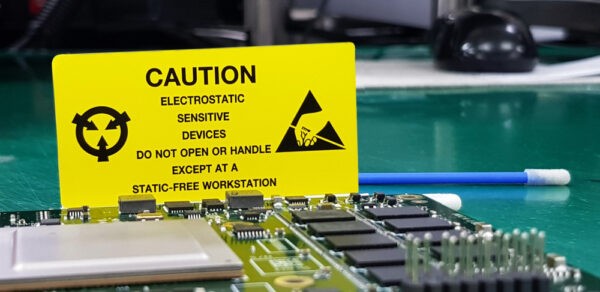Best Practices for Preventing Electrostatic Discharge Hazards

In manufacturing environments, electrostatic discharge (ESD) hazards pose significant threats to product quality and worker safety. ESD can result in irreversible damage to sensitive electronic components, leading to costly failures and production delays. Moreover, ESD incidents can endanger the well-being of personnel.
Mitigating ESD hazards comes down to situational awareness and preventive best practices. By implementing proactive measures, manufacturers can safeguard their operations, enhance product reliability, and protect both their workforce and bottom line. Here’s how.
The risks of electrostatic discharge
Electrostatic discharge is a phenomenon occurring when there’s a sudden flow of electricity between two objects with different electric potentials. In manufacturing, ESD hazards are abundant and can stem from a variety of sources.
The primary dangers of electrostatic discharge encompass equipment damage and loss of productivity. They can also lead to product defects, severe financial loss, and — worst of all — worker injuries. Ignoring ESD hazards can be risky, but being aware of preventative measures such as ESD-safe equipment, grounding, and humidity control can mitigate these risks.

Implementing ESD prevention measures
Manufacturers can strengthen their ESD prevention measures by implementing safeguards to address the root causes of electrical buildup and discharge. Here’s some practical guidance on how to protect workers and equipment from ESD:
- Provide employee training and awareness programs. Offer employee training sessions to educate personnel on the importance of proper grounding, personal protective equipment (PPE), ESD awareness, and safe handling procedures.
- Establish an ESD control plan. A control plan typically involves designating ESD protective areas and implementing grounding and bonding techniques. Protective areas such as ESD-safe rooms or workstations can help prevent electrostatic charges from accumulating in specific locations. Grounding and bonding devices safely discharge any static buildup.
- Select appropriate ESD-safe materials and equipment. Investing in ESD-safe workstations, furniture, and flooring can help to minimize static buildup. Clothing and accessories made of ESD-safe materials — such as static-free footwear or conductive gloves — can also contribute to a comprehensive control plan.
- Use ESD control devices and safeguards. Anti-static wrist straps and footwear are safeguards to transfer any electrical buildup through the wearer. Additionally, ESD mats, ionizers, and shielding bags provide an added layer of protection.
- Test and monitor preventive measures. Once implemented, ESD control measures should be tested and periodically monitored. Many ESD control devices are subject to wear and tear and can lose their protective properties over time.

Best practices for ESD prevention
Safeguarding your factory floor from ESD helps ensure electronic components are handled correctly to avoid damage. More importantly, it keeps your workers safe. By adhering to the following ESD prevention best practices, you can reduce instances of electrostatic discharge:
- Minimize movement and friction. Manufacturing environments must have ESD-resistant flooring and footwear to minimize static electricity generation. Workers should avoid sliding items across plastic surfaces, and carts used for transportation should have conductive wheels.
- Control humidity levels. Some electronic products are sensitive to humidity, which can increase the likelihood of ESD. Manufacturers should invest in HVAC systems and dehumidifiers to control humidity levels and reduce the risk of ESD.
- Minimize static-generating activities. Static electricity can be generated during brushing, wiping, and cleaning various surfaces. Manufacturers should use anti-static brushes and wipes to clean surfaces and utilize conductive vacuum cleaners in ESD-sensitive areas.
- Monitor and audit ESD prevention. Regular testing of workers’ equipment and materials can identify compliance issues and help maintain a high level of ESD prevention. A proactive approach saves money and lives.
Education on ESD is critical. When employees understand electrostatic discharge concerns, they can actively seek to mitigate them. It’s yet another form of workplace safety training not to overlook.